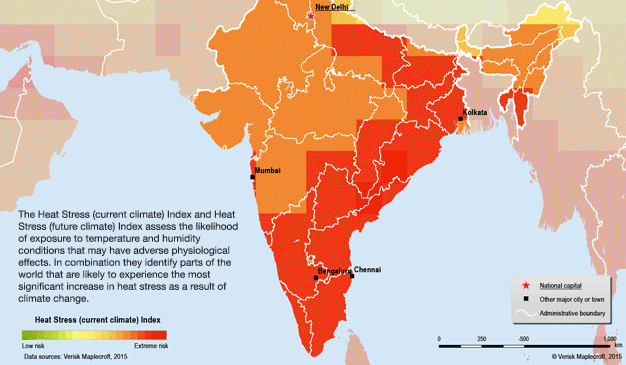The misery index, a creation of web developer Cameron Beccario, that analyses wind patterns and surface temperatures makes it clear how bad things are in India. The map measures wind pattens plus "misery" – a combination of wind chill and surface temperatures. Black spots on the map are mean temperatures, moving up to red as it gets warmer and yellow tending to white when people are truly miserable. As you can see, lots of people in India have good reason not to be very happy.
Things have been particularly bad in the two states of Andhra Pradesh and Telangana, which have seen more than 1,200 casualties between them. Some of this may be due to the state authorities not reacting appropriately to the heat wave, by, for example, not halting construction work even at peak temperatures.
But some of it is pure weather. The Wet-Bulb Globe Temperature, a composite temperature that adds in humidity, wind speed and radiation, is widely used as a measure of exposure levels to high temperatures and heat stress. When the WGBT exceeds 25°C people begin to feel the effects of heat stress, according to general standards developed by hygienists.
Verisk Maplecroft, a risk analysis company, estimates that Andhra Pradesh currently faces about 200 days over this threshold ever year, with Telangana not far behind at 180 days. Maharashtra has a lot fewer, at 147 days, and Punjab just 121. Delhi sees 148 days over 25°C every year.
This map, put together by the company, shows the likelihood of exposure to heat and humidity that may have "adverse physiological effects" on people in Indian states, with the focus being south and east India.

Go forward to the middle of the century, by 2050, however and a mix of climate change and further urbanisation means things are going to be horrifically hot all over the country. From 147 days over 25°C, Maharashtra is going to have 210 heat stress days. Punjab gets a whole month of extra hot days, from 121 to 151. Days in Delhi where the temperatures will be over 30°C go from 14 to a whopping 57, nearly two whole months. As for Andhra Pradesh and Telangana? The former will have 230 days over 25°C and the latter up to 250.
The numbers are based on estimates by James Allan and Richard Hewston, who work on climate change and the environment for Verisk.











